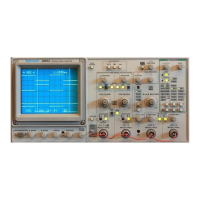Controls, Connectors, and Indicators
NOISE REJ coupling Is useful for improving stability when the trigger
signal Is accompanied by low-level noise.
HF REJ (High Frequency Reject)—Attenuates high-frequency
triggering signal components above 50 kHz.
HF REJ coupling is useful for providing a stable display of
low-frequency components of complex waveforms and eliminates
high-frequency interference from the trigger signal.
LF REJ (Low Frequency Reject)—Attenuates low-frequency trig
gering signal components below 100 kHz and blocks the dc component
of the trigger signal.
LF REJ coupling is useful for producing stable triggering on the high-
frequency components of complex waveforms and rejecting
low-frequency interference or power supply hum from the trigger
signal.
AC—Attenuates trigger signal frequency components below 50 Hz
and blocks the dc component of the signal.
AC coupling Is useful for triggering on ac waveforms that have a large
dc offset.
Rear Panel
Refer to Figure 2-6 for location of items 39 through 41.
(39) EXT Z-AXIS INPUT Connector—Connects external signals to the
Z-Axis amplifier for intensity modulating the crt display.
Signals applied to the EXT Z-AXIS INPUT do not affect display
waveshape. Signals with fast rise times and fall times provide the
most abrupt intensity change. The active region threshold level Is
1.8 V. Z-Axis voltage above the threshold voltage decreases the
intensity, and 3.8 V or more produces noticeable modulation. The
Z-Axis signals must be time-related to the displayed signal to obtain a
fixed intensity-modulated crt display.
(40) Fuse Holder—Contains the primary power fuse.
2245A Operators
2-17

